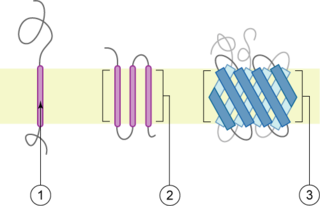Solute carrier family 22 member 13 is a protein that in humans is encoded by the SLC22A13 gene. [5]
Solute carrier family 22 member 13 is a protein that in humans is encoded by the SLC22A13 gene. [5]
This gene encodes a member of the organic-cation transporter family. It is located in a gene cluster with another member of the family, organic cation transporter like 4. The encoded protein is a transmembrane protein involved in the transport of small molecules. This protein can function to mediate urate uptake and is a high affinity nicotinate exchanger in the kidneys and the intestine.

Solute carrier family 22, member 4, also known as SLC22A4, is a human gene; the encoded protein is known as the ergothioneine transporter.

Solute carrier family 22 member 2 is a protein that in humans is encoded by the SLC22A2 gene.

Solute carrier family 22 member 1 is a protein that in humans is encoded by the gene SLC22A1.

Solute carrier family 22 member 3 (SLC22A3) also known as the organic cation transporter 3 (OCT3) or extraneuronal monoamine transporter (EMT) is a protein that in humans is encoded by the SLC22A3 gene.

Solute carrier family 22 member 11 is a protein that in humans is encoded by the SLC22A11 gene.

Solute carrier family 22 member 8, or organic anion transporter 3 (OAT3), is a protein that in humans is encoded by the SLC22A8 gene.

Solute carrier family 22, member 12, also known as SLC22A12 and URAT1, is a protein which in humans is encoded by the SLC22A12 gene.

Solute carrier family 22 member 18 is a protein that in humans is encoded by the SLC22A18 gene.

Sodium/myo-inositol cotransporter is a protein that in humans is encoded by the SLC5A3 gene.

Multidrug and toxin extrusion protein 1 (MATE1), also known as solute carrier family 47 member 1, is a protein that in humans is encoded by the SLC47A1 gene. SLC47A1 belongs to the MATE family of transporters that are found in bacteria, archaea and eukaryotes.

Cationic amino acid transporter 3 is a protein that in humans is encoded by the SLC7A3 gene.

Solute carrier family 2, facilitated glucose transporter member 9 is a protein that in humans is encoded by the SLC2A9 gene.

Solute carrier family 13 member 3 also called sodium-dependent dicarboxylate transporter (NaDC3) is a protein that in humans is encoded by the SLC13A3 gene.

Solute carrier family 22 member 7 is a protein that in humans is encoded by the gene SLC22A7.

Solute carrier family 22 member 9 is a protein that in humans is encoded by the SLC22A9 gene.

Solute carrier family 6, member 18 also known as SLC6A18 is a protein which in humans is encoded by the SLC6A18 gene.

The organic anion transporter 1 (OAT1) also known as solute carrier family 22 member 6 (SLC22A6) is a protein that in humans is encoded by the SLC22A6 gene. It is a member of the organic anion transporter (OAT) family of proteins. OAT1 is a transmembrane protein that is expressed in the brain, the placenta, the eyes, smooth muscles, and the basolateral membrane of proximal tubular cells of the kidneys. It plays a central role in renal organic anion transport. Along with OAT3, OAT1 mediates the uptake of a wide range of relatively small and hydrophilic organic anions from plasma into the cytoplasm of the proximal tubular cells of the kidneys. From there, these substrates are transported into the lumen of the nephrons of the kidneys for excretion. OAT1 homologs have been identified in rats, mice, rabbits, pigs, flounders, and nematodes.

Solute carrier family 22 member 25 (SLC22A25), also known as organic anion transporter UST6, is a protein that in humans is encoded by the SLC22A25 gene.

Solute carrier family 17, member 3 is a protein that in humans is encoded by the SLC17A3 gene.

Solute carrier family 22 member 14 is a protein that in humans is encoded by the SLC22A14 gene.
This article incorporates text from the United States National Library of Medicine, which is in the public domain.
| This article on a gene on human chromosome 3 is a stub. You can help Wikipedia by expanding it. |